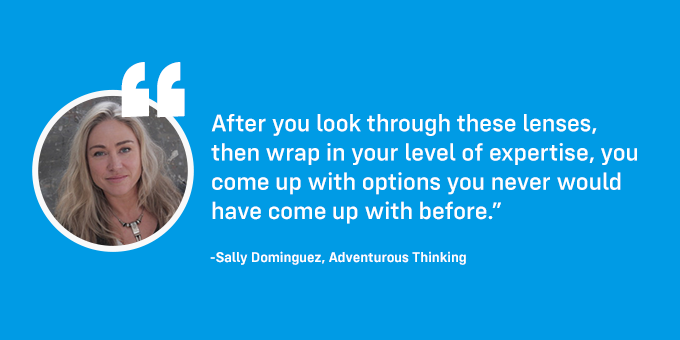
Finding the Big Idea: 5 Ways to Approach Innovation From Different Perspectives
Sally Dominguez is a 10X Innovation Activator and Strategist, and the founder of Adventurous Thinking Group. With an extensive background in architecture and product design, Sally is an ambassador for Engineers Without Borders Australia, and has won more than 7 international product design awards.
Her Adventurous Thinking process requires looking at problems from “multifarious perspectives.” Multifarious is defined as “many or of various types.” It’s an apt phrase not only for Sally’s approach, but her own background.

A multifarious career
Sally describes her path to product design as an “anything but linear background.” She began her career as an architect, but soon switched her focus to product design after creating an easy-cleaning high chair for her daughter.
The design resulted in the development of a new type of plastic finish in rotomolding and won numerous design awards; and she subsequently licensed it. She also designed a rainwater tank that would fit in tight spaces in reaction to Australia’s drought.
With both products, Sally ignored the skeptics. “My consistent quality is that when people tell me something isn’t going to work, I don’t really listen,” she said. “I assume there is another way, and I constantly look around. Now I understand that’s the theory of multiple intelligences.”
Check out more on Sally in the video overview:
Adventurous Thinking – it’s “swirly”
Sally has applied the theory of multiple intelligence to “Adventurous Thinking.” This isn’t a linear process, it’s “swirly,” and it’s how innovators are able to generate new ideas on a consistent basis.
With the process, you approach a problem or challenge from multiple angles. At worst, you get to know the problem better. At best, you come up with all types of new innovations and solutions.

Because this isn’t intuitive and can be uncomfortable, Sally has developed five different “lenses” to facilitate the different perspectives. “After you look through these lenses, then wrap in your level of expertise, you come up with options you never would have come up with before, ” she said.
The five lenses approach
Sally said it’s fascinating to watch organizations ranging from NASA to school systems use the approach. Here’s an overview of the five different lenses:
Lens #1 – Negative space
Negative space helps you focus on how a product is not being used, or how you’re not delivering on customer’s expectations.
Sally cites the example of an American Express Call Center. Call center reps were answering phone calls efficiently, which made their financial people happy. However, customers were feeling rushed.
By delving into that negative space, Amex decided to always ask customers if there was anything else they could help with to ensure the customer felt satisfied. It’s now a best practice throughout the industry.
Lens #2 – Sideways
Design thinking is about empathy. You listen to the customers, then take the idea back to them.
It’s a great process, but there’s simply not enough time for it in today’s rapidly moving marketplace.
Instead, your company needs to “fail fast.” And the fastest way to do that is to understand your implicit bias, and how your team thinks. It helps you see the options you may not necessarily like, but are what your customers truly want.
Lens #3 – Backwards
We typically don’t think about products in terms of life cycles. With the “backwards” lens, you put a time frame on your project, and then work backwards from the end date.
Sally shared an example of the company Fitbit rolling out their product in Brazil in a 12-month time frame. The time constraints forced Fitbit to consider what needed to happen to reach saturation, and what types of resources would need to be employed.
Lens #4 – ReThink
The ReThink lens focuses on your core values: What is it you do, how do you do it, and your overall intrinsic value. Once those are identified, you consider:
Magnifiers – how you scale your intrinsic value for growth.
Minimizers – how you deliver a person-to-person experience.
After creating those for your core market or demographic, you apply the same process to another type of customer to explore new, unexpected markets.
Lens #5 – Parkour
This lens prompts the most “extreme disruptive thinking,” according to Sally. It throws people into an area of “bearable discomfort.”
As an example of Parkour, she used our interview for this post as an example. The conversation was recorded using the video conference app Zoom.
Under the Parkour lens, we would ask what if we couldn’t use the Zoom app, or a cell phone, or email to conduct the interview? How would we get it done?
“Because you’ve inverted a best practice, you have to come up with a new system,” Sally said. This new system tends to be most disruptive, because it’s a complete departure from best practices.
Bonus content: Check out Sally’s interview with award-winning pattern-breaking toy designer Dan Klitsner:
Transforming Adventurous Thinking into ongoing thinking
We’re accustomed to ideating for a new product or service. But how does Sally’s approach adapt to daily operations?
It actually conforms nicely with lean operations. “You keep the process open, and continue to look at it through every different stage,” she said. “It’s designed to be implemented in five-minute increments.”

Thinking from different perspectives on an ongoing basis allows for continuous ideation, as opposed to locking everyone in a room for a brainstorm session. (Which tends to produce blank stares and boatloads of frustration.)
Adventurous thinking itself is an evolving process. Sally is continuously on the prowl for new lenses, and new innovative ways to shake people out of their comfort zone.
Sally is delivering the keynote presentation at the ATX West / MD&M West Tradeshow, where we’ll be exhibiting in booth 4511 and presenting two advanced converting machines demonstrations. Hope to see you there.

